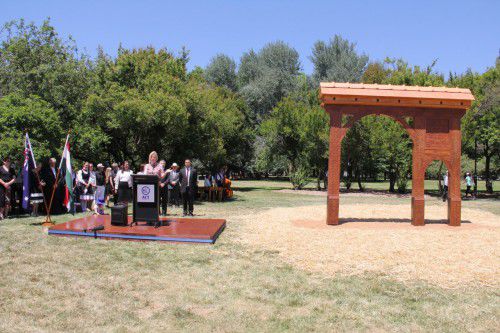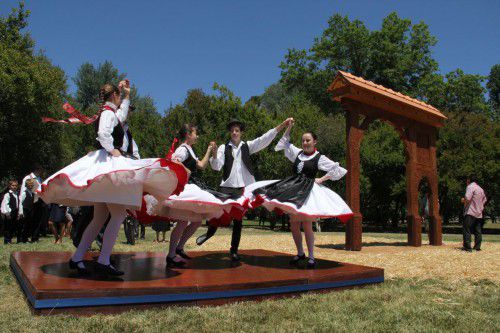CHIEF Minister Katy Gallagher and Bronwyn Bishop welcomed the Speaker of the National Assembly of Hungary László Kövér to Bowen Park on Sunday where they accepted a unique Centenary gift – a hand carved wooden gate – on behalf of the people of Canberra.
“I am delighted to accept this beautiful and unique hand carved wooden gate which symbolises the lasting friendship between the people of Australia and Hungary,” Katy said.
“While the gateway will continue to stand tall at Bowen Park, the relationship between Australia and Hungary will continue to go from strength to strength as it has done since the diplomatic relations between our two countries were fully established in 1972.
Young Hungarian artist Balázs Gábor designed the ornate piece which includes Canberra’s flower emblem the Royal Bluebell as well as a variety of flowers traditionally used in Hungarian folk art such as the tulip.
The words of Hungarian writer Áron Tamási are also carved in the gate. They read ‘We were born to the world to be at home somewhere’.
“I hope that all who walk through the gateway feel at home in the tranquil environment of Bowen Park and enjoy the sense of place, culture and community the new gateway creates,” the Chief Minister concluded.
“CityNews”, however, has been in receipt of a communication claiming we shouldn’t call it a Hungarian gate. The Canberra & District Hungarian Cultural Association has written to inform us:
Regrettably, the Székelykapu in Canberra has been incorrectly referred to as a ‘Hungarian Gate’ instead of a ‘Székely Gate’.
Székelykapu – Szekler Gate
Székely (Szekler in English) is a region now in Romania which is historically Hungarian.
On 4 June 1920 the Trianon Dictate detached from Hungary over 2/3rds of the territory including the land of the Székely’s, along with 1/3rd of the population. The Székely population even today use the Hungarian language which is their mother tongue, but they deprived as the official language of public administration, education and even the language of religion is Romanian. Due to the Peace Dictate the Székely indigenous people today are under foreign domination and experience extreme oppression in all aspects of life and are deprived of their human rights.
In this region varied “székelykapu” (http://www.hungarianclub.org/KapuE.php) have succeeded in preserving ancient traditions. The Székely and Transylvanian crafts are part of Hungarian heritage. They are famous for carving wood, which is the most extended form of traditional art, along with weaving fabrics. The Sun and Moon are the symbols of the Székely; they appear on the flag and also, in stylised form, in their carvings.
The best known carved items are the Székely gates. They used to be made of good quality oak trees and less frequently of pine trees. Among the gates built ages before in large areas of eastern Europe the most numerous and technically interesting are preserved in Transylvania. The traditional Szeklers’ hospitality does not allow gates to be closed. They are open to everybody, both happy and miserable, like the open and philanthropic hearts of Szeklers. This is expressed frequently by the inscriptions on the arches of the gates: “Peace to the newcomers, blessing with the leavers”.
The Székely gate comprises two parts: the small gate, also called the pedestrian gate, is used for people to walk into their garden. It usually has a welcoming message engraved on it, often saying “God brought you” which means that whoever enters the garden is welcomed by the owners of the house. Next to it, and kept as one single unit, there is the large gate, also called the carriage gate, opened only when carriages stacked with hay or wood need to enter the yard.
Source: http://greentransylvania.com/arts-crafts/szekely-gates/
History of the Székelykapu
Origins of the ancestral carved gates of Transylvania span thousands of years before the Common Era (B.C.) and transcend beyond the boundaries of the Carpathian Mountains to Mesopotamia and the Far East. Similar to the ancient “Silk Route” that connected Central Europe to the Far East, these gates stood in witness to civilisations from the great city of “Úr” in Mesopotamia and the Far East.
This ancient art with a system of mythical symbols and richness of form is still practised and still inspires Hungarian Szeklers of Transylvania in creating their home environment and preserving their traditions to this day. The “Székelykapu” had symbolic meaning which separated East from West artistically as well as geographically and politically. Most remarkably each gate was and still is a unique individual work of art, one of a kind, but serving the same practical purpose: keeping the “outside world” outside and guarding the sanctuary of the home within. It is not by accident one finds the runic inscriptions on front of the gate “The Lord has brought thee here” while on the other side departing guests can read “The Lord be with thee”.
The word “Úr” translates as Lord and is carved exactly the same way as it can be seen in the City of Úr photographed for the first time by Sir Leonard Wooley, discoverer of the ancient Sumerian City and author of several books among them “Úr of the Chaldees” (London, 1950). His excavations revealed several motifs carved into stone which are completely identical with leading motifs of Hungarian but especially Transylvanian Folk Art such as the upward scrolling or spiralling lines, tree of life, sun as central motif, runic symbols, five and eight petal rose, pomegranate and cornflower.
Other gates that have withstood the ravages of time have been mostly carved from oak as is the custom even today. In the top centre under the roof and pigeon loft (representing peace), the traditional sign of the sun, symbol of Úr is carved and under it the ancient greeting ISTEN HOZOTT. Besides individual decorations, the main post which separated the large wagon gate from the small walk-in gate, displayed the family history in runic writing (rovásírás). Each generation added it’s share of history and when all sides were filled, a new supporting post was hewn from oak and placed on either side of the walk-in gate. There is a custom of carving, in runic writing, family history into the gateposts. In addition to the inherited symbols and decorations, a greeting, name of the homestead builder and date of completion is also carved into the gate and remains a tradition.
Source: http://www.hungarianclub.org/KapuE.php
Hungary may have been torn apart, but the Hungarian Nation is inseparable. Therefore, the Hungarian Nation consists of three parts:
1. Hungarians living in today’s Hungary;
2. Hungarians in the Carpathian Basin which have been severed due to the Peace Dictate; and
3. Hungarians in diaspora.
I hope we’ve all learned something today.
Who can be trusted?
In a world of spin and confusion, there’s never been a more important time to support independent journalism in Canberra.
If you trust our work online and want to enforce the power of independent voices, I invite you to make a small contribution.
Every dollar of support is invested back into our journalism to help keep citynews.com.au strong and free.
Thank you,
Ian Meikle, editor






Leave a Reply